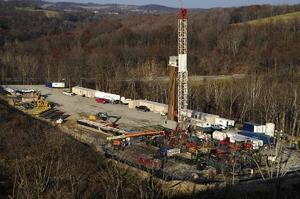DisastersIncreased U.S earthquakes may be caused by fracking
From 1970 to 2000 the number of magnitude 3.0 or greater temblors in the U.S. mid-continent averaged twenty-one annually; by 2011 the number of such quakes had increased to 134; a new study by the U.S. Geological Survey links the increase of seismic activity to the increase in the use of hydraulic fracturing, or fracking

Fracking operation in southwest Pennsylvania // Source: trumbullcountygaslease.com
A U.S. Geological Survey abstract says there has been a substantial increase in seismic activity in the U.S. mid-continent. 2011 saw a 6-fold increase in the number of magnitude 3.0 or greater temblors, when compared to the twentieth century average of such earthquakes.
From 1970 to 2000 the number of such quakes averaged twenty-one annually, plus or minus 7.6 per year. By 2011 the number of such events had increased to 134.
The abstract links the increase of seismic activity to the increase in the use of hydraulic fracturing, or fracking, as a means of extracting petroleum and natural gas, concluding that the earthquake rate changes are “almost certainly manmade, it remains to be determined how they are related to either changes in extraction methodologies or the rate of oil and gas production.”
Hydraulic fracturing introduces water with a mixture of chemicals deep below ground. This pressurized liquid forces open the normally occurring fissures in the rock in which the petroleum or natural gas is deposited.
By expanding the size of these fissures, the gas or oil flow more freely into reservoirs from which it can be easily extracted. The technique has opened up vast shale-gas and oil deposits which, according to Businessweek, has forced natural gas prices to their lowest level in a decade.
It is unclear whether the fracking itself is responsible for the increased number of earthquakes. Some experts contend that the wastewater produced by the process, which is injected into wells located far below the acquifers, is actually the culprit.
An increase in seismic activity has been tied to deep wells since a 1990 report by the USGS and the Environmental Protection Agency. The EPA found that the injection of fluids into deep wells caused an increase in seismic activity in a number of states, including New York, New Mexico, Nebraska, Ohio, and several others.
The EPA is expected to issue guidance to help state regulators assess earthquake risks, though, ultimately, it is up to the states to regulate the wells in order to maintain clean drinking water.
Last year Arkansas regulators permanently shut four disposal wells in the Fayetteville Shale after an outbreak of earthquakes near the town of Guy, including on measuring 4.7 on the Richter scale.
This year the state’s Oil and Gas Commission adopted a set of regulations requiring drillers to provide reports on the structural geology of the drilling sites, and to position wells away from known faults.
Other states are also either issuing or considering issuing regulations concerning both fracking and deep well drilling as evidence continues to accumulate indicating a connection between the two and increased seismic activity.
